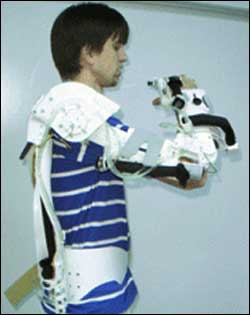Robotic Arm Could Help Stroke Survivors Regain Range of Motion

A robotic arm that can be worn at home is being developed to help stroke survivors regain the ability to reach and grasp objects and perform basic tasks such as feed themselves.
The device, built by a research team, led by biomedical engineer Jiping He, Ph.D., and his colleagues at Arizona State University and Kinetic Muscles, Inc., a start up biotech company, can also assess the effectiveness of the physical therapy so adjustments can be made to the regimen if necessary. He will present a paper on the robotic arm this summer at the 9th International Conference on Rehabilitation Robotics in Chicago.
Recent research suggests that stroke survivors can recover significant use of their arms by performing repetitive motor function exercises over a period of time. This labor intensive physical therapy is expensive, however, claiming up to 4 percent of the national health budget, according to the National Institutes of Health. Moreover, health insurers may limit or deny coverage before stroke survivors achieve best results, He said.
“This device is intended to provide cost-effective therapy to a wider population for a longer period of time for maximum recovery of motor function,” He said of the device, dubbed RUPERT I, for Robotic Upper Extremity Repetitive Therapy.
RUPERT I is powered by four pneumatic muscles and is movable at the shoulder, elbow and wrist. The design was based on a kinematics model of the arm, which showed where to locate the pneumatic muscles and how much force was needed for normal reaching and feeding movements. The mechanical arm is adjustable to accommodate different arm lengths and body sizes.
The first prototype was fitted and tested on able-bodied individuals and stroke survivors at Banner Good Samaritan Regional Medical Center in Phoenix. Eight able-bodied individuals tried on RUPERT I to see how well it could be adjusted to fit each in each case. The testers ranged from 5-foot females to over-6-foot males. In addition, two stroke survivors completed a three-week course of therapy using the device.
RUPERT II, a second generation prototype, is under development using results of the fitting evaluations and therapy testing at the medical center.
Contact:
Jiping He, Arizona State University
Frank Blanchard, The Whitaker Foundation
Media Contact
More Information:
http://www.whitaker.orgAll latest news from the category: Health and Medicine
This subject area encompasses research and studies in the field of human medicine.
Among the wide-ranging list of topics covered here are anesthesiology, anatomy, surgery, human genetics, hygiene and environmental medicine, internal medicine, neurology, pharmacology, physiology, urology and dental medicine.
Newest articles

Properties of new materials for microchips
… can now be measured well. Reseachers of Delft University of Technology demonstrated measuring performance properties of ultrathin silicon membranes. Making ever smaller and more powerful chips requires new ultrathin…

Floating solar’s potential
… to support sustainable development by addressing climate, water, and energy goals holistically. A new study published this week in Nature Energy raises the potential for floating solar photovoltaics (FPV)…

Skyrmions move at record speeds
… a step towards the computing of the future. An international research team led by scientists from the CNRS1 has discovered that the magnetic nanobubbles2 known as skyrmions can be…





















